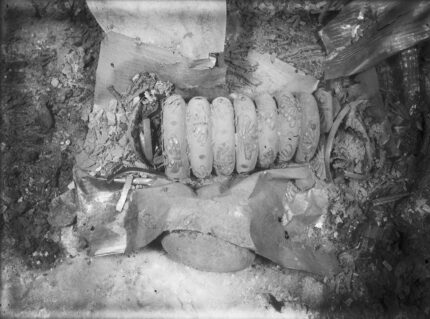A new study of silver bracelets discovered in the tomb of 4th Dynasty Queen Hetepheres I has revealed the silver was imported from Greece 4,600 years ago. Lead isotope analysis narrowed the silver’s source to the Cyclades, with the Lavrion mines in Attica as the second most likely place of origin.
Hetepheres I was the wife of 4th Dynasty pharaoh Sneferu and mother of Khufu, builder of the Great Pyramid at Giza. Her tomb was discovered at Giza in 1925 in the shadow of her son’s pyramid. Although her white alabaster sarcophagus was empty, likely robbed of its precious contents, the tomb contained a wealth of grave goods including gilded furniture, jewelry, gold vessels and the oldest intact set of canopic jars ever discovered in an ancient Egyptian tomb.
 Perhaps the most notable of Hetepheres’ funerary furnishings were found inside the remains of a wood box covered with gold sheeting. It held a collection of 20 deben-rings, bracelets worn ten to an arm. Some of them were fragmentary, but even with some corrosion and loss, the queen’s bracelets were and remain to this day the largest collection of silver artifacts from early Egypt found. They were crafted of silver inlaid with turquoise, lapis lazuli and carnelian in the shape of butterflies.
Perhaps the most notable of Hetepheres’ funerary furnishings were found inside the remains of a wood box covered with gold sheeting. It held a collection of 20 deben-rings, bracelets worn ten to an arm. Some of them were fragmentary, but even with some corrosion and loss, the queen’s bracelets were and remain to this day the largest collection of silver artifacts from early Egypt found. They were crafted of silver inlaid with turquoise, lapis lazuli and carnelian in the shape of butterflies.
The style and materials of the inlay are Egyptian, but not the silver. Old Kingdom silver is very rare. Egypt has no native silver ore deposits and silver artifacts don’t make a consistent appearance on the archaeological record until the Middle Bronze Age (around 1900 B.C.). Queen Hetepheres I’s bracelets were a testament to her great wealth and status.
A hundred years after their discovery, the bracelets have for the first time been subjected to compositional, mineralogical, microscopic and isotopic analysis.
“The origin of silver used for artefacts during the third millennium has remained a mystery until now,” said Dr Karin Sowada, from the Department of History and Archaeology at Macquarie University. “This new finding demonstrates, for the first time, the potential geographical extent of trade networks used by the Egyptian state during the early Old Kingdom at the height of the Pyramid-building age.”
The silver was likely acquired through the port of Byblos on the Lebanese coast and is the earliest attestation of long-distance exchange activity between Egypt and Greece.
The research team included leading scientists from France and the Museum of Fine Arts in Boston, where several bracelets are located. Their analysis also revealed the methods of early Egyptian silver working for the first time.
“Samples were analysed from the collection in the Museum of Fine Arts in Boston, and the scanning electron microscope images show that the bracelets were made by hammering cold-worked metal with frequent annealing to prevent breakage,” said Professor Damian Gore from Macquarie University’s School of Natural Sciences.
The findings have been published in the Journal of Archaeological Science: Reports and can be read here.
